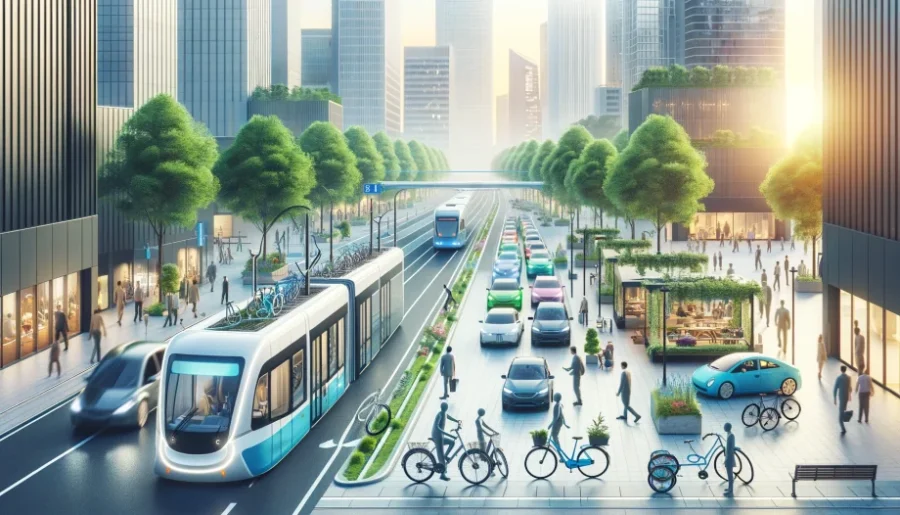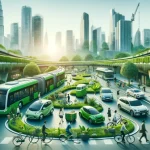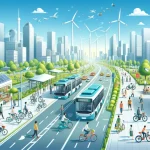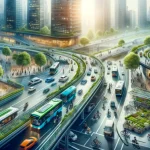
Explore sustainable mobility solutions with us! Dive into the future of eco-friendly transport that’s reshaping our cities. Let’s ride towards a greener planet together.
Sustainable Mobility Solutions
Key Takeaways:
- Sustainable mobility solutions include:
- Electric vehicles
- Public transportation systems
- Bike-sharing programs
- Walking.
- These eco-friendly options reduce carbon emissions
- Combat climate change
- Improve urban air quality
- They make cities more livable and sustainable for future generations.
Welcome to the world of sustainable mobility solutions!
Imagine streets filled with electric vehicles, cities designed for walking and biking, and public transport that’s both efficient and eco-friendly.
It’s not just a dream—it’s our future. Join us as we explore how these innovative solutions are paving the way for a cleaner, healthier planet.
Introduction to Sustainable Mobility
What Is Sustainable Mobility Or Sustainable Transport?
Sustainable transport refers to ways of transportation that are sustainable in terms of their social and environmental impacts. Components for evaluating sustainability include the particular vehicles used for road, water or air transport; the source of energy; and the infrastructure used to accommodate the transport (roads, railways, airways, waterways, canals and terminals). Wikipedia
Understanding Sustainable Mobility
Sustainable mobility is a forward-thinking strategy that aims to fulfill our current transport needs while ensuring future generations can do the same.
It includes various transport methods such as electric vehicles, public transportation, and active travel like walking and biking.
These modes are focused on minimizing environmental impacts, particularly through reducing carbon emissions and pollution.
Sustainable mobility is the term used to refer to transportation from an environmental or ecological mindset. Ultimately, the goal for sustainable mobility is to mitigate the use of excessive fuel consumption and reduce emissions so that our ecosystems can replenish themselves. Greenly Earth
The Significance of Climate Action
This approach is vital in the battle against climate change. The transport sector is a major contributor to global greenhouse gas emissions.
Transitioning to sustainable transport methods can drastically cut these emissions, playing a key role in global climate mitigation efforts.
Demand in Urbanization
The rise in urban populations has escalated the demand for sustainable transportation solutions.
Urban areas, now more than ever, require efficient, reliable, and eco-friendly transport options.
This demand stems from the need to address environmental challenges and manage the congestion and pollution typical of densely populated cities.
Towards Greener Cities
Sustainable mobility is integral to developing smarter, more livable urban environments.
By embracing sustainable transportation, cities can become more inclusive and accessible, enhancing the quality of life for their residents while promoting environmental stewardship.
This introduction sets the stage for a deeper exploration of sustainable mobility solutions, highlighting their importance in today’s urbanized and environmentally conscious world.
1. Electric Vehicles: Driving Towards a Greener Future
Revolutionizing Transport with EVs
Electric Vehicles (EVs) are at the forefront of the shift towards sustainable mobility.
They represent a key innovation in the transportation sector, offering a cleaner alternative to traditional gasoline and diesel-powered vehicles.
Unlike their fossil-fueled counterparts, EVs operate on electric power, significantly reducing the pollutants released into the environment.
Impact on Environment and Economy
EVs play a critical role in reducing greenhouse gas emissions.
By utilizing electricity as their power source, they emit far fewer pollutants compared to internal combustion engine vehicles.
This reduction is vital in combating climate change and improving air quality in urban areas.
Furthermore, as EVs become more widespread, they contribute to decreasing our dependence on oil and other fossil fuels, leading to a more sustainable and secure energy future.
Technological Advancements and Infrastructure Development
The evolution of EV technology has been rapid, with significant improvements in battery life, charging times, and vehicle range.
Modern EVs are now more accessible and practical for everyday use, addressing one of the major barriers to adoption.
Concurrently, the development of charging infrastructure has accelerated, with an increasing number of public and private charging stations being installed worldwide.
This growing network makes it easier for EV owners to charge their vehicles, further encouraging the transition to electric transport.
Table: Electric Vehicles: Driving Towards a Greener Future
| Feature | Description |
|---|---|
| Role in Sustainability | EVs significantly reduce greenhouse gas emissions and dependence on fossil fuels. |
| Technological Advancements | Improvements in battery life, charging times, and vehicle range. |
| Infrastructure Development | Expansion of public and private EV charging stations worldwide. |
These advancements in EV technology and infrastructure are pivotal in driving the shift towards greener, more sustainable transportation solutions.
As the automotive industry continues to innovate, electric vehicles are set to play an even more significant role in shaping the future of mobility, leading us towards a cleaner, more sustainable world.
2. Public Transportation: The Backbone of Urban Mobility
Essential to Sustainable Urban Development
Public transportation systems are vital for sustainable urban development.
They provide an efficient, reliable, and affordable way for people to get around, reducing the need for private vehicles.
This not only minimizes traffic congestion but also significantly lowers pollution and greenhouse gas emissions.
Cities with robust public transit systems see improved air quality, reduced carbon footprints, and enhanced accessibility for all residents, contributing to more livable and sustainable urban environments.
Critical for Sustainable Cities
- Efficiency and Accessibility: Public transportation is crucial for reducing the reliance on private vehicles, which, in turn, cuts down traffic congestion and lowers pollution.
- Environmental Benefits: By offering a shared mode of transport, public systems significantly reduce carbon emissions and contribute to cleaner air.
Innovations Enhancing Public Transit
- Electric Buses: Cities are adopting electric buses to cut carbon emissions and noise pollution, aligning with sustainable urban development goals.
- Smart Technology Integration: Enhancements like real-time tracking and mobile ticketing make public transportation more convenient and efficient.
- Mobility-as-a-Service (MaaS): Combining different modes of transport into a single, accessible platform, MaaS simplifies travel planning and encourages public transit use.
Driving Innovations for Efficiency and Service
Innovations in public transportation are constantly evolving to meet the demands of modern urban life.
- These advancements aim to improve energy efficiency and the overall service experience for commuters. For instance, many cities are now integrating electric buses into their fleets, which operate on clean energy, reducing carbon emissions and noise pollution.
- Additionally, smart technology is being employed to streamline operations and enhance passenger convenience.
- Real-time tracking, mobile ticketing, and integrated mobility-as-a-service (MaaS) platforms allow for smoother, more efficient transit experiences. These systems enable commuters to easily plan their journeys, combining different modes of transport for the fastest, most convenient route.
Table: Public Transportation: The Backbone of Urban Mobility
| Feature | Description |
|---|---|
| Importance | Reduces traffic congestion and pollution; enhances urban livability. |
| Innovations | Electric buses, real-time data apps for improved passenger experience. |
| Benefits | Lower emissions, reduced urban sprawl, increased accessibility. |
Such innovations not only make public transportation more appealing but also more accessible.
By investing in these technologies, cities can encourage more people to choose transit options over private cars, moving closer to achieving sustainable mobility goals.
As public transportation becomes more efficient and user-friendly, it strengthens its role as the backbone of urban mobility, supporting the development of greener, more resilient cities.
3. Alternative Energy Sources for Transportation
Diversifying Energy for Greener Transit
The transition to sustainable transportation is increasingly powered by alternative energy sources.
Fuel cells, hybrid vehicles, and renewable energies are at the forefront of this shift, offering cleaner, more efficient ways to power our journeys.
- Fuel Cells: Utilizing hydrogen to produce electricity, fuel cell vehicles emit only water vapor, making them a promising zero-emission option. They’re especially suited for heavier vehicles and long distances, where battery-electric vehicles may face limitations.
- Hybrid Vehicles: Combining an internal combustion engine with an electric motor, hybrid vehicles offer improved fuel efficiency and lower emissions than conventional vehicles. They serve as a practical step toward fully electric transportation.
- Renewable Energy Sources: Solar, wind, and hydroelectric power are increasingly used to charge electric vehicles, further reducing the carbon footprint of electric transportation. The integration of renewable energy into the electric grid makes EV charging cleaner and more sustainable.
Potential and Challenges
Integrating these alternative energy sources into the transportation sector holds immense potential for reducing our dependency on fossil fuels and cutting greenhouse gas emissions.
However, the path forward comes with its challenges:
- Infrastructure Development: Building the necessary infrastructure for fuel cell vehicles and widespread EV charging, particularly with renewable energy, requires significant investment and coordination.
- Technological Advances: Further technological improvements are needed to increase the efficiency and reduce the costs of fuel cell systems, hybrid technologies, and renewable energy production.
- Policy and Market Support: Government policies and incentives play a crucial role in promoting alternative energy vehicles and infrastructure. Additionally, consumer acceptance and market demand are vital for widespread adoption.
Table: Alternative Energy Sources for Transportation
| Energy Source | Potential | Challenges |
|---|---|---|
| Fuel Cells | High energy efficiency, zero tailpipe emissions | High costs, hydrogen infrastructure development |
| Hybrid Vehicles | Reduced emissions, fuel efficiency | Higher upfront costs than conventional vehicles |
| Renewable Energy | Sustainable power for EVs, lower operational costs | Intermittency, need for large-scale storage solutions |
The push towards alternative energy sources in transportation is a critical component of achieving sustainable mobility.
By overcoming the challenges and harnessing the potential of these technologies, we can pave the way for a cleaner, greener transportation future.
4. Smart Cities and Intelligent Transportation Systems
Elevating Urban Mobility with Smart Solutions
Smart city initiatives and Intelligent Transportation Systems (ITS) are transforming urban mobility, making it more efficient, safer, and environmentally friendly.
By leveraging technology such as IoT (Internet of Things), AI (Artificial Intelligence), and big data analytics, these systems optimize the flow of traffic, improve public transportation, and reduce congestion and emissions.
- Enhanced Traffic Management: ITS uses sensors and AI to monitor traffic conditions in real-time, adjusting traffic signals to reduce congestion and improve flow, thereby reducing idle times and emissions.
- Public Transit Optimization: Smart systems provide real-time data on public transport schedules and capacities, enabling commuters to make informed decisions that streamline their travel and reduce wait times.
- Eco-Friendly Routing: GPS and mapping services integrate real-time traffic data to offer the most fuel-efficient routes for drivers, cyclists, and pedestrians alike.
Smart Mobility Solutions in Action
Several cities globally are pioneering smart mobility solutions with notable success:
- Integrated Mobility Platforms: Cities like Helsinki have implemented MaaS platforms that integrate various forms of transport into a single application, offering a seamless, efficient way to plan and pay for trips combining public transit, bike-share, car-share, and more.
- Autonomous Public Transit: In places like Singapore, autonomous buses and shuttles are being tested to provide flexible, efficient, and safe public transportation options, particularly in less densely populated areas.
- Smart Traffic Lights: Cities such as Pittsburgh, USA, have deployed smart traffic signals that adapt to real-time traffic conditions, significantly reducing wait times at intersections and cutting down on fuel consumption.
- Electric Vehicle Charging Networks: Urban centers are expanding their EV charging infrastructure, integrating renewable energy sources to power electric vehicles, as seen in Amsterdam’s city-wide charging network.
Table: Smart Cities and Intelligent Transportation Systems
| Feature | Description |
|---|---|
| Smart Mobility Solutions | Includes autonomous vehicles, ITS, MaaS platforms. |
| Benefits | Improved traffic flow, reduced congestion, enhanced public transit efficiency. |
| Examples | Real-time traffic management, smart parking, integrated transport apps. |
These examples illustrate the potential of smart city and ITS technologies to revolutionize urban transportation.
By adopting these innovative solutions, cities can significantly enhance mobility while minimizing their environmental footprint, marking a critical step toward sustainable urban development.
5. Active Transport: Walking and Cycling
Enhancing Health and Environment through Active Mobility
Active transport, including walking and cycling, is not only beneficial for personal health but also plays a crucial role in reducing environmental emissions.
Engaging in these forms of transportation helps decrease the reliance on motor vehicles, leading to lower carbon emissions and contributing to cleaner air quality.
Additionally, active transport promotes physical activity, which is linked to numerous health benefits such as reduced risk of chronic diseases, improved mental health, and enhanced overall well-being.
Urban Planning for Accessible Active Transport
Creating cities that support walking and cycling is essential for encouraging active transport. Urban planning that prioritizes these modes involves:
- Dedicated Bike Lanes and Pedestrian Paths: Implementing safe, continuous, and well-maintained infrastructure is key to encouraging cycling and walking. Cities successful in promoting active transport often feature expansive networks of bike lanes and pedestrian zones that are separated from motor vehicle traffic.
- Traffic Calming Measures: Reducing vehicle speeds in urban areas through traffic calming measures (e.g., speed bumps, narrowed roads) makes streets safer for cyclists and pedestrians, encouraging their use for daily commutes and leisure activities.
- Connectivity and Accessibility: Ensuring that cycling and walking infrastructure is connected and accessible encourages people to choose these modes of transport for their daily needs. This includes direct routes to key destinations such as schools, workplaces, and shopping areas.
- Public Spaces and Greenways: Creating attractive public spaces and greenways not only enhances the urban landscape but also provides pleasant and safe routes for walking and cycling. These areas offer a respite from the urban environment and promote active lifestyles among city dwellers.
Table: Active Transport: Walking and Cycling
| Feature | Description |
|---|---|
| Health and Environmental Impact | Promotes physical health, reduces emissions. |
| Urban Planning Needs | Safe, continuous infrastructure for walking and biking; traffic calming measures. |
| Benefits | Improved air quality, reduced traffic congestion, enhanced community well-being. |
By investing in walking and cycling infrastructure and prioritizing active transport in urban planning, cities can foster healthier communities and make significant strides towards sustainability.
Such initiatives not only improve the quality of life for residents but also contribute to the broader goals of reducing traffic congestion, lowering emissions, and creating more livable, vibrant urban spaces.
6. Shared Mobility: Car Sharing and Electric Scooters
Revolutionizing Urban Transport with Shared Mobility
The rise of shared mobility services, including car sharing and electric scooters, has dramatically changed the landscape of urban transportation.
These services offer convenient, flexible, and cost-effective alternatives to private vehicle ownership and public transportation, catering to the dynamic needs of modern city dwellers.
By enabling users to access vehicles on an as-needed basis, shared mobility reduces the number of privately owned cars on the road, contributing to decreased traffic congestion, lower emissions, and a reduced need for parking spaces.
Benefits for Urban Transport
- Reduced Carbon Footprint: Shared vehicles, especially electric ones, play a significant role in lowering greenhouse gas emissions by optimizing vehicle usage and reducing the total number of vehicles required to meet transportation needs.
- Enhanced Accessibility: Car sharing and electric scooters make it easier for residents and visitors to navigate cities, filling the gaps in public transportation networks and providing a viable option for last-mile connectivity.
- Economic Advantages: By minimizing the need for private car ownership, shared mobility can lead to significant savings for individuals, reducing expenses related to purchasing, maintaining, and insuring a private vehicle.
Challenges and Opportunities
While shared mobility presents numerous benefits, scaling these solutions comes with its set of challenges:
- Regulatory Hurdles: Cities and municipalities must navigate regulatory challenges to effectively integrate shared mobility into existing transportation ecosystems, ensuring safety and equity without stifling innovation.
- Infrastructure Adaptation: Developing the necessary infrastructure, such as designated parking areas for shared vehicles and charging stations for electric scooters and cars, is crucial for the expansion of shared mobility services.
- Public Acceptance: Encouraging a shift in public perception from vehicle ownership to shared use is essential for the widespread adoption of these services. This involves promoting the reliability, convenience, and environmental benefits of shared mobility.
Despite these challenges, the opportunities presented by shared mobility for creating more sustainable, efficient, and livable cities are immense.
By addressing these hurdles, urban areas can harness the full potential of shared mobility services, paving the way for a future of transportation that is more inclusive, environmentally friendly, and adaptable to the evolving needs of urban populations.
7. Policy and Planning for Sustainable Mobility
Shaping the Future with Policies and Planning
Government policies and urban planning play a pivotal role in fostering sustainable mobility.
By setting regulations, providing funding, and designing cities with sustainable transportation in mind, governments can significantly influence how people move around urban areas.
Effective policies and planning can encourage the use of public transport, walking, cycling, and electric vehicles, contributing to reduced emissions, improved air quality, and enhanced urban livability.
Successful Policies from Around the Globe
- The Paris Agreement on Climate Change: While not a direct transportation policy, the Paris Agreement has prompted countries to reduce their carbon emissions, with many focusing on the transportation sector as a key area for improvement. Nations are adopting various strategies, including incentives for electric vehicle purchase and investment in renewable energy, to meet their emissions reduction targets.
- Congestion Charging in London, UK: Introduced in 2003, London’s congestion charge aims to reduce traffic congestion in the city center, encouraging the use of public transportation and reducing pollution. The revenue generated from the charge is invested back into London’s transport network, further enhancing sustainable mobility options.
- Copenhagen’s Bicycle Infrastructure: Denmark’s capital, Copenhagen, is renowned for its cycling culture, supported by extensive bicycle infrastructure and policies encouraging cycling. The city’s investment in bike lanes, parking, and traffic laws prioritizing cyclists has made it one of the most bicycle-friendly cities in the world.
- Singapore’s Integrated Public Transport System: Singapore has developed an efficient and comprehensive public transport system, supported by policies that discourage private car ownership through high fees and taxes. The government’s investment in the public transport network, including the Mass Rapid Transit (MRT) system, buses, and active mobility infrastructure, has made public transport a convenient option for the majority of the population.
Table: Policy and Planning for Sustainable Mobility
| Policy Example | Impact |
|---|---|
| Paris Agreement on Climate Change | Global emissions reduction targets, influencing transportation policies. |
| London’s Congestion Charging | Reduced city-center traffic, improved air quality, revenue invested in transport. |
| Copenhagen’s Bicycle Infrastructure | Increased cycling rates, reduced vehicle traffic, enhanced urban livability. |
| Singapore’s Public Transport System | High public transit usage, reduced private car dependency, comprehensive mobility solutions. |
These case studies demonstrate the effectiveness of targeted government policies and urban planning in promoting sustainable mobility.
By prioritizing the development and implementation of sustainable transport solutions, cities can achieve significant environmental, economic, and social benefits, setting a strong foundation for a sustainable future.
8. The Future of Transportation
Navigating Towards Sustainable Futures
The transportation sector is on the cusp of a major transformation, driven by emerging trends and technologies that promise to redefine how we move.
Sustainable transportation is at the heart of this shift, emphasizing the need for systems that are not only efficient and convenient but also environmentally friendly and accessible to all.
Emerging Trends and Technologies
- Autonomous Vehicles (AVs): Self-driving cars are set to revolutionize the transportation landscape by improving traffic flow, reducing accidents caused by human error, and optimizing energy use.
- Electrification of Public Transit: The shift towards electric buses and trains continues to gain momentum, significantly reducing the carbon footprint of public transport networks.
- Mobility as a Service (MaaS): This concept integrates various forms of transport into a single accessible service, allowing users to plan, book, and pay for multiple types of transportation from a smartphone app.
- Green Urban Planning: Cities around the world are reimagining urban spaces to prioritize pedestrians, cyclists, and public transport, reducing the need for private cars and enhancing the quality of urban life.
The Role of Innovation and Investment
Innovation, backed by strategic investment, is crucial in bringing these emerging trends to fruition.
Governments, along with private sector stakeholders, are investing heavily in research and development to overcome technical and infrastructural challenges associated with sustainable transportation.
This includes funding for cleaner energy sources, smarter cities, and more efficient vehicles.
- Public-Private Partnerships: Collaborations between governments and private companies are proving essential for advancing sustainable transportation projects, from electric vehicle charging infrastructure to smart city initiatives.
- Global Cooperation: International cooperation on standards, policies, and technology sharing is vital for addressing global challenges like climate change and ensuring the widespread adoption of sustainable mobility solutions.
The future of transportation is poised to be more sustainable, efficient, and inclusive, shaped by continuous innovation and investment.
As we move forward, the integration of new technologies with proactive policy-making and urban planning will play a pivotal role in achieving these goals, ensuring a greener, more connected world.
FAQ Section: Understanding Sustainable Mobility
In this section, we address some of the most common questions about sustainable mobility, offering clear insights into what it means, how it can be managed, and its foundational principles.
Whether you’re new to the concept or looking to deepen your understanding, these FAQs provide essential knowledge for navigating the future of transportation.
Q: What is sustainable mobility?
A: Sustainable mobility refers to transportation methods and systems that are environmentally friendly, economically viable, and socially inclusive.
It encompasses a wide range of practices and technologies designed to reduce the environmental impact of transportation, improve public health and safety, and enhance accessibility for all users.
Q: How can we improve sustainable mobility?
A: Improving sustainable mobility involves several strategies, including:
- Investing in and prioritizing public transportation to reduce reliance on private vehicles.
- Encouraging the use of active transport options like walking and cycling through improved urban design.
- Promoting the adoption of electric and low-emission vehicles by developing charging infrastructure and offering incentives.
- Implementing smart city technologies to optimize traffic flow and reduce congestion.
Q: What is sustainable mobility management?
A: Sustainable mobility management is the process of planning, implementing, and controlling transportation systems and policies to ensure they are environmentally sustainable, economically feasible, and socially equitable.
This includes managing demand for private vehicle use, enhancing public transport services, and ensuring infrastructure supports a range of sustainable transport options.
Q: What is meant by sustainable mobility?
A: Sustainable mobility means creating transportation systems that are capable of meeting current mobility needs without compromising the ability of future generations to meet theirs.
It emphasizes minimizing environmental damage, promoting energy efficiency, and enhancing the quality of life for all community members.
Q: What are the three pillars of sustainable mobility?
A: The three pillars of sustainable mobility are environmental sustainability, economic viability, and social equity.
These pillars support a balanced approach to transportation planning that respects the planet’s ecological limits, is financially accessible to all, and ensures fair access to mobility options across different societal groups.
Q: What are 4 types of sustainable development?
A: The four types of sustainable development are:
- Economic Sustainability: Ensuring that economic growth is achieved without depleting natural resources.
- Environmental Sustainability: Protecting natural resources and minimizing pollution and waste.
- Social Sustainability: Promoting social equity, inclusiveness, and quality of life.
- Cultural Sustainability: Preserving and fostering cultural diversity and heritage.
Q: What are the 4 major components of sustainable development?
A: The four major components of sustainable development include economic growth, environmental stewardship, social inclusion, and cultural preservation.
These components ensure a holistic approach to development that respects and balances the needs of both people and the planet.
Q: What are the three (3) core elements of sustainability? Explain each.
A: The three core elements of sustainability are:
- Environmental Protection: This involves conserving natural resources and ecosystems to support life on Earth for future generations.
- Economic Growth: Economic policies and practices that ensure long-term economic health without harming the environment or society.
- Social Equity: Ensuring equitable access to resources and opportunities for all individuals, regardless of their background.
Q: Are there 3 or 4 pillars of sustainability?
A: Traditionally, sustainability is based on three pillars: economic, environmental, and social.
However, some frameworks include a fourth pillar, cultural sustainability, recognizing the importance of preserving cultural heritage and diversity in sustainable development.
Q: What are the pillars of sustainable transportation?
A: The pillars of sustainable transportation are similar to those of sustainability at large, focusing on environmental protection, economic efficiency, and social equity.
These pillars ensure transportation systems contribute to a healthier environment, are accessible and affordable for all users, and support economic development.
Q: Who created the 3 pillars of sustainability?
A: The concept of the three pillars of sustainability has evolved over time and is a result of collective international dialogue and agreement, notably crystallized during the United Nations Conference on Environment and Development (UNCED) in Rio de Janeiro in 1992, also known as the Earth Summit.
Conclusion: Embracing Sustainable Mobility for a Healthier Planet
Throughout this exploration of sustainable mobility, we’ve delved into the transformative power of environmentally friendly transportation solutions.
From the rise of electric vehicles and the vital role of public transportation to the adoption of active transport modes like walking and cycling, each component plays a crucial role in shaping a more sustainable future.
We’ve seen how shared mobility services such as car sharing and electric scooters can reduce urban congestion and emissions, and how smart city initiatives and intelligent transportation systems enhance the efficiency and accessibility of urban mobility.
The Significance of Government Policies and Urban Planning
The significance of government policies and urban planning in promoting sustainable mobility cannot be overstated.
Successful case studies from around the world demonstrate the potential for innovative solutions to revolutionize how we move, making transportation not only cleaner but also more inclusive and accessible.
The Future of Sustainable Mobility Solutions
As we look towards the future, emerging trends and technologies in sustainable transportation offer a glimpse of the exciting possibilities ahead.
The role of innovation and investment in shaping this future is paramount, signaling a shift towards a mobility landscape that prioritizes both the planet’s health and our own.
Encouragement to Adopt Sustainable Mobility Solutions
We encourage everyone to consider how sustainable mobility solutions can be integrated into their daily lives.
Whether it’s choosing to cycle or walk for short journeys, opting for public transport, or considering an electric vehicle for your next car purchase, every action contributes to a larger movement towards reducing our environmental footprint.
Together, by embracing sustainable mobility, we can pave the way for a healthier planet and a brighter future for generations to come.
Let’s make conscious choices to support sustainable transportation options in our communities, advocating for policies and infrastructure that facilitate this transition.
By doing so, we not only enhance our quality of life but also ensure the well-being of our environment.
Resources
For those interested in further exploring sustainable mobility solutions, here are some valuable resources and articles:
- Sustainable Mobility: A Review of Possible Actions and Policies on MDPI: This article provides a comprehensive review of actions and policies to promote sustainable mobility, covering a wide range of studies and research from different perspectives.
- Transforming Cities: The Rise of Sustainable Mobility Solutions on Automotive Technology: This piece discusses the importance of infrastructure and policies in supporting the proliferation of sustainable mobility solutions.
- Why the future of sustainability will start with mobility on the World Economic Forum: An insightful article that discusses the EU Green Deal’s objectives for reducing CO₂ emissions and the role of shared mobility services in achieving these goals.
- Achieving just transitions to low-carbon urban mobility on Nature: This publication explores the concept of distributive justice in low-carbon mobility transitions, highlighting the importance of equitable access to sustainable transportation technologies.
- The Future of Sustainable Mobility on McKinsey & Company: A report that examines the systemic changes needed to create circularity in the automotive sector, focusing on the potential for significant emission reductions.
- Sustainable Mobility for the 21st Century by the World Bank Group: An overview of the environmental and social challenges associated with managing the mobility of people and goods, and the strategies to address them.
- Towards a More Sustainable Mobility on SpringerLink: This article delves into micromobility solutions, offering insights into their benefits for short-distance, flexible, and cost-effective transport.
These articles provide a deep dive into the various facets of sustainable mobility, from policies and technologies to innovations and challenges, offering readers a well-rounded perspective on the subject.






